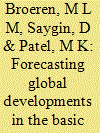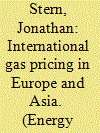|
|
|
Sort Order |
|
|
|
Items / Page
|
|
|
|
|
|
|
| Srl | Item |
| 1 |
ID:
126827


|
|
|
|
|
| Publication |
2014.
|
| Summary/Abstract |
We analyze oil export behavior by Saudi Arabia and the Rest of OPEC since 1973. In the literature there has been a wide range of estimates of their correlation: from positive, to zero, to negative. We find that the correlation has varied over time, from moderately high (0.7) in normal periods, to negative during each of five interruptions; the average correlation has been 0.19. Saudi Arabia's oil market behavior depends upon circumstances, but its primary goal is the stability of OPEC and the world oil market. It will coordinate export reductions with the Rest of OPEC when faced with declining demand, but it will increase exports when faced with interruptions elsewhere in OPEC. Allowing for such differences provides evidence of intelligent, context-dependent consistency. But ignoring context - by wrongly assuming the same Saudi response in Normal periods and Interruptions - can lead to a conclusion of Saudi "inconsistency" because the difference in the responses has been obscured.
|
|
|
|
|
|
|
|
|
|
|
|
|
|
|
|
| 2 |
ID:
126806


|
|
|
|
|
| Publication |
2014.
|
| Summary/Abstract |
We examine the implications of increased unconventional crude oil production in North America. This production increase has been made possible by the existence of alternative oil-recovery technologies and persistently elevated oil prices that make these technologies commercially viable. We first discuss the factors that have enabled the United States to expand production so rapidly and the glut of oil inventory that has accumulated in the Midwest as a result of logistical challenges and export restrictions. Next, we assess the extent to which the increase in U.S. domestic production will affect global supply conditions and whether the U.S. experience can be repeated in other countries with unconventional oil sources. The evidence suggests that even in the best-case scenario, the increase in U.S. oil production is unlikely to have a large effect on the global oil market's demand-supply balance, so its effect on the price of oil is expected to be limited. Furthermore, the United States enjoys unique infrastructural and technological advantages that make it unlikely that rapid increases in unconventional production can be achieved elsewhere.
|
|
|
|
|
|
|
|
|
|
|
|
|
|
|
|
| 3 |
ID:
126817


|
|
|
|
|
| Publication |
2014.
|
| Summary/Abstract |
Bottom-up models of oil production are continuously being used to guide investments and policymaking. Compared to simpler top-down models, bottom-up models have a number of advantages due to their modularity, flexibility and concreteness. The purposes of this paper is to identify the crucial modeling challenges, compare the different ways in which nine existing models handle them, assess the appropriateness of these models, and point to possibilities of further development. The conclusions are that the high level of detail in bottom-up models is of questionable value for predictive accuracy, but of great value for identifying areas of uncertainty and new research questions. There is a potential for improved qualitative insights through systematic sensitivity analysis. This potential is at present largely unrealized.
|
|
|
|
|
|
|
|
|
|
|
|
|
|
|
|
| 4 |
ID:
126830


|
|
|
|
|
| Publication |
2014.
|
| Summary/Abstract |
Rural buildings in China now account for more than half of China's total building energy use. Forty percent of the floorspace in China is in rural villages and towns. Most of these buildings are very energy inefficient, and may struggle to provide for basic needs. They are cold in the winter, and often experience indoor air pollution from fuel use. The Chinese government plans to adopt a voluntary building energy code, or design standard, for rural homes. The goal is to build on China's success with codes in urban areas to improve efficiency and comfort in rural homes. The Chinese government recognizes rural buildings represent a major opportunity for improving national building energy efficiency. The challenges of rural China are also greater than those of urban areas in many ways because of the limited local capacity and low income levels. The Chinese government wants to expand on new programs to subsidize energy efficiency improvements in rural homes to build capacity for larger-scale improvement. This article summarizes the trends and status of rural building energy use in China. It then provides an overview of the new rural building design standard, and describes options and issues to move forward with implementation.
|
|
|
|
|
|
|
|
|
|
|
|
|
|
|
|
| 5 |
ID:
126825


|
|
|
|
|
| Publication |
2014.
|
| Summary/Abstract |
It is now widely recognized that there is a strong relationship between energy consumption and economic growth. Most countries' energy demands declined during the economic depression of 2008-2009 when a worldwide economic crisis occurred. As an export-oriented economy, China suffered a serious exports decline in the course of the crisis. However, it was found that energy consumption continued to increase. Against such a background, this paper aims to assess and explain the factors causing the growth of energy consumption in China. First, we will explain the impact of domestic final use and international trade on energy consumption by using decomposition analysis. Second, embodied energy and its variation across sectors are quantified to identify the key sectors contributing to the growth. Lastly, the policy implications for long-term energy conservation are discussed. The results show that the decline in exports was one of the driving forces for energy consumption reduction in the crisis, but that the growth of domestic demand in manufacturing and construction, largely stimulated by economic stimulus plans, had the opposite effect on energy consumption. International trade contributed to decreasing energy consumption of China during and after the crisis because the structure of exports and imports changed in this period.
|
|
|
|
|
|
|
|
|
|
|
|
|
|
|
|
| 6 |
ID:
126841


|
|
|
|
|
| Publication |
2014.
|
| Summary/Abstract |
The energy sector is the biggest contributor of anthropogenic emissions of greenhouse gases into the atmosphere in Iran. However, abundant potential for implementing low-carbon technologies offers considerable emissions mitigation potential in this sector, and technology transfer is expected to play an important role in the widespread roll-out of these technologies. In the current work, globally existing low-carbon energy technologies that are compatible with the energy sector of Iran are identified and then prioritised against different criteria (i.e. Multi Criteria Decision Analysis). Results of technology prioritisation and a comprehensive literature review were then applied to conduct a SWOT analysis and develop a policy package aiming at facilitating the transfer of low carbon technologies to the country. Results of technology prioritisation suggest that the transport, oil and gas and electricity sectors are the highest priority sectors from technological needs perspective. In the policy package, while fuel price reform and environmental regulations are categorised as high priority policies, information campaigns and development of human resources are considered to have moderate effects on the process of technology transfer.
|
|
|
|
|
|
|
|
|
|
|
|
|
|
|
|
| 7 |
ID:
126824


|
|
|
|
|
| Publication |
2014.
|
| Summary/Abstract |
This paper attempts to explore the strategies for breaking the deadlock between the demand for resolving climate crisis and the resistance to deploying nuclear power. Since our present renewable technology is not advanced enough to replace fossil fuel power plants, nuclear power becomes the only available means that can buy us more time to explore better energy sources for coping with the dilemma of global warming and energy security. Therefore, this paper proposes an elaborated fear appeal framework that may shed light on the intervention points for mitigating fear. By examining the influence of fear appeal on the nuclear issue, three strategies for demarketing the nuclear fear of the public are recommended. The paper concludes that only when energy policy makers and the nuclear industry recognize the significance of minimizing fear and begin to work on removing the sources of fear, can we then expect to bring the nuclear issue back to rational discourse.
|
|
|
|
|
|
|
|
|
|
|
|
|
|
|
|
| 8 |
ID:
126838


|
|
|
|
|
| Publication |
2014.
|
| Summary/Abstract |
This paper examines the implications of alternative forms of cap-and-trade regulations on the California electricity market. Specific focus is given to the implementation of a downstream form of regulation known as the first-deliverer policy. Under this policy, importers (i.e., first-deliverers) of electricity into California are responsible for the emissions associated with the power plants from which the power originated, even if those plants are physically located outside of California. We find that, absent strict non-economic barriers to changing import patterns, such policies are extremely vulnerable to reshuffling of import resources. The net impact implies that the first-deliverer policies will be only marginally more effective than a conventional source-based regulation.
|
|
|
|
|
|
|
|
|
|
|
|
|
|
|
|
| 9 |
ID:
126800


|
|
|
|
|
| Publication |
2014.
|
| Summary/Abstract |
We show that the application of flexible semi-parametric statistical techniques enables significant improvements in model fitting of macroeconomic models. As applied to the explanation of the past economic growth (since 1900) in US, UK and Japan, the new results demonstrate quite conclusively the non-linear relationships between capital, labour and useful energy with economic growth. They also indicate that output elasticities of capital, labour and useful energy are extremely variable over time. We suggest that these results confirm the economic intuition that growth since the industrial revolution has been driven largely by declining energy costs due to the discovery and exploitation of relatively inexpensive fossil fuel resources. Implications for the 21st century, which are also discussed briefly by exploring the implications of an ACEGES-based scenario of oil production, are as follows: (a) the provision of adequate and affordable quantities of useful energy as a pre-condition for economic growth and (b) the design of energy systems as 'technology incubators' for a prosperous 21st century.
|
|
|
|
|
|
|
|
|
|
|
|
|
|
|
|
| 10 |
ID:
126815


|
|
|
|
|
| Publication |
2014.
|
| Summary/Abstract |
Up until recently Peak Oil was a major discussion point crossing from academic research into mainstream journalism, yet it now attracts far less interest. This paper evaluates the reasons for this and on-going relevance of Peak Oil, considering variations in predictive dates for the phenomenon supported by technological, economic and political issues. Using data from agencies, the validity of each position is assessed looking at reserves, industrial developments and alternative fuels. The complicating issue of demand is also considered.
The conclusions are that, supported by commercial interests, an unsubstantiated belief in market and technical solutions, and a narrow paradigmatic focus, critics of Peak Oil theory have used unreliable reserve data, optimistic assumptions about utilisation of unconventional supplies and unrealistic predictions for alternative energy production to discredit the evidence that the resource-limited peak in the world's production of conventional oil has arrived, diverting discussion from what should be a serious topic for energy policy: how we respond to decreasing supplies of one of our most important energy sources.
|
|
|
|
|
|
|
|
|
|
|
|
|
|
|
|
| 11 |
ID:
126821


|
|
|
|
|
| Publication |
2014.
|
| Summary/Abstract |
The near- and long-term societal effects of declining EROI are uncertain, but probably adverse. A major obstacle to examining social implications of declining EROI is that we do not have adequate empirical understanding of how EROI is linked, directly or indirectly, to an average citizen's ability to achieve well-being. To evaluate the possible linkages between societal well-being and net energy availability, we compare these preliminary estimates of energy availability: (1) EROI at a societal level, (2) energy use per capita, (3) multiple regression analyses and (4) a new composite energy index (Lambert Energy Index), to select indicators of quality of life (HDI, percent children under weight, health expenditures, Gender Inequality Index, literacy rate and access to improved water). Our results suggest that energy indices are highly correlated with a higher standard of living. We also find a saturation point at which increases in per capita energy availability (greater than 150 GJ) or EROI (above 20:1) are not associated with further improvement to society.
|
|
|
|
|
|
|
|
|
|
|
|
|
|
|
|
| 12 |
ID:
126826


|
|
|
|
|
| Publication |
2014.
|
| Summary/Abstract |
Although Saudi Arabia is the largest exporter of oil in the world, the country is well aware of the fact that this will be a scarce resource in the near future. As the domestic sector of Saudi Arabia is the largest consumer of electricity, the needs of energy efficiency (EE) must start in the homes of its inhabitants. Due to a harsh climate most of the year plus the cheapest electricity rates in the world, the EE culture is finding it difficult to penetrate the population. The Government of Saudi Arabia is striving hard to focus the EE programmes on the industrial and commercial sectors. With the proposed introduction of the Efficient Management of Electrical Energy Regulation, and amendments, EE within the commercial and industrial sector would be further enhanced. These developments, coupled with the recent increase in energy cost worldwide, spells a real need to develop local experts with the required knowledge and experience in EE. This article discusses various aspects of EE and certification of Energy Managers in terms of academic requirements as well as the accreditation requirements needed from training institutes. Various technical aspects of the process have been discussed in view of labour-market requirements and perspective.
|
|
|
|
|
|
|
|
|
|
|
|
|
|
|
|
| 13 |
ID:
126820


|
|
|
|
|
| Publication |
2014.
|
| Summary/Abstract |
All forms of economic production and exchange involve the use of energy directly and in the transformation of materials. Until recently, cheap and seemingly limitless fossil energy has allowed most of society to ignore the importance of contributions to the economic process from the biophysical world as well as the potential limits to growth. This paper centers on assessing the energy costs of modern day society and its relation to GDP. Our most important focus is the characteristics of our major energy sources including each fuel's energy return on investment (EROI). The EROI of our most important fuels is declining and most renewable and non-conventional energy alternatives have substantially lower EROI values than traditional conventional fossil fuels. At the societal level, declining EROI means that an increasing proportion of energy output and economic activity must be diverted to attaining the energy needed to run an economy, leaving less discretionary funds available for "non-essential" purchases which often drive growth. The declining EROI of traditional fossil fuel energy sources and the effect of that on the world economy are likely to result in a myriad of consequences, most of which will not be perceived as good.
|
|
|
|
|
|
|
|
|
|
|
|
|
|
|
|
| 14 |
ID:
126803


|
|
|
|
|
| Publication |
2014.
|
| Summary/Abstract |
European energy and climate change policy rests on two main pillars: the internal energy market (IEM), and the climate change package (CCP). The IEM aimed at third party access and unbundling, neglecting the physical infrastructure and the basis for asset valuations and hence the harmonisation of network charges. The Commission plans to complete the IEM by 2014-almost a quarter of a century after embarking on the policy. Yet even if all the IEM directives are implemented, the EU will remain far from a single competitive market. The CCP was grounded on short term targets (the 2020-20-20 programme) on the assumption that fossil fuel prices would rise, making renewables competitive, and hence yielding a competitive advantage to the EU. The EUETS was intended to lead the way to a global trading system and an international agreement at Copenhagen. The EU has reduced the production of carbon emissions, but only as a result of de-industrialisation and slow growth, and at the expense of rising carbon consumption. Renewables have not led to green growth, but rather to a further eroding of competitiveness. The EUETS price has collapsed. In order for the EU to put the IEM and the CCP back on track, both need to be radically reconsidered. The IEM requires a refocusing on physical infrastructure, common accounting rules and an EU-wide approach to capacity markets and renewables trading. The CCP requires a refocusing on carbon consumption, on limiting the dash-for-coal, and on future rather than current renewables.
|
|
|
|
|
|
|
|
|
|
|
|
|
|
|
|
| 15 |
ID:
126818


|
|
|
|
|
| Publication |
2014.
|
| Summary/Abstract |
Due to the increasing importance of natural gas for modern economic activity, and gas's non-renewable nature, it is extremely important to try to estimate possible trajectories of future natural gas production while considering uncertainties in resource estimates, demand growth, production growth and other factors that might limit production. In this study, we develop future scenarios for natural gas supply using the ACEGES computational laboratory. Conditionally on the currently estimated ultimate recoverable resources, the 'Collective View' and 'Golden Age' Scenarios suggest that the supply of natural gas is likely to meet the increasing demand for natural gas until at least 2035. The 'Golden Age' Scenario suggests significant 'jumps' of natural gas production - important for testing the resilience of long-term strategies.
|
|
|
|
|
|
|
|
|
|
|
|
|
|
|
|
| 16 |
ID:
126833


|
|
|
|
|
| Publication |
2014.
|
| Summary/Abstract |
The chemical sector is the largest industrial energy user, but detailed analysis of its energy use developments lags behind other energy-intensive sectors. A cost-driven forecasting model for basic chemicals production is developed, accounting for regional production costs, demand growth and stock turnover. The model determines the global production capacity placement, implementation of energy-efficient Best Practice Technology (BPT) and global carbon dioxide (CO2) emissions for the period 2010-2030. Subsequently, the effects of energy and climate policies on these parameters are quantified. About 60% of new basic chemical production capacity is projected to be placed in non-OECD regions by 2030 due to low energy prices. While global production increases by 80% between 2010 and 2030, the OECD's production capacity share decreases from 40% to 20% and global emissions increase by 50%. Energy pricing and climate policies are found to reduce 2030 CO2 emissions by 5-15% relative to the baseline developments by increasing BPT implementation. Maximum BPT implementation results in a 25% reduction. Further emission reductions require measures beyond energy-efficient technologies. The model is useful to estimate general trends related to basic chemicals production, but improved data from the chemical sector is required to expand the analysis to additional technologies and chemicals.
|
|
|
|
|
|
|
|
|
|
|
|
|
|
|
|
| 17 |
ID:
126832


|
|
|
|
|
| Publication |
2014.
|
| Summary/Abstract |
Many different governments have begun to require disclosure of building energy performance, in order to allow owners and prospective buyers to incorporate this information into their investment decisions. These policies, known as disclosure or information policies, require owners to benchmark their buildings and sometimes conduct engineering audits. However, given substantial variation in the cost to disclose different types of information, it is natural to ask: how much and what kind of information about building energy performance should be disclosed, and for what purposes? To answer this question, this paper assembles and cleans a comprehensive panel dataset of New York City multifamily buildings, and analyzes its predictive power using a Bayesian multilevel regression model. Analysis of variance (ANOVA) reveals that building-level variation is the most important factor in explaining building energy use, and that there are few, if any, relationships of building systems to observed energy use. This indicates that disclosure laws requiring benchmarking data may be relatively more useful than engineering audits in explaining the observed energy performance of existing buildings. These results should inform the further development of information disclosure laws.
|
|
|
|
|
|
|
|
|
|
|
|
|
|
|
|
| 18 |
ID:
126839


|
|
|
|
|
| Publication |
2014.
|
| Summary/Abstract |
Scarcity or abundance of energy resources usually depends on physical and geographical conditions in the region. However, the energy flow in the region also depends on the efficient use of energy resources, the consumption rate of energy and the possibility to use local renewable and non-renewable energy resources. Production, distribution and the use of energy resources in the region are the challenges for central and local government, business and social service, customers and other stakeholders. Development of regional energy economy should be optimized according to the available energy flow in the region using a network system analysis method, which provides solutions for developing sustainable energy economy models. The network system analysis method enables to optimize the use of local and renewable resources at the regional level and reveals available local energy resources. An efficient use of available regional resources and the use of renewable energy sources (RES) should be the main goals for the development of regional energy system. RES can compete with traditional fossil fuel with the condition that all hidden aspects are revealed. The network system analysis method enables to indicate energy flows in the region as well as indicate pros and cons of using renewable energy technologies.
|
|
|
|
|
|
|
|
|
|
|
|
|
|
|
|
| 19 |
ID:
126805


|
|
|
|
|
| Publication |
2014.
|
| Summary/Abstract |
In Continental Europe and LNG importing Asia, international gas prices reflect the market fundamentals of the 1970s-1990s when gas was replacing oil products and crude oil in energy balances. By the end of the 2000s, fundamentals in both these regions had changed significantly, but gas price formation mechanisms had not. This created major problems for buyers locked into long term contracts indexed to crude oil and oil product prices, which had risen to levels far above gas market fundamentals. By 2013, the transition to hub-based pricing was well advanced in Europe and dominant in the large markets in the north west of the Continent. In Asia the "crisis of fundamentals" was only just starting to be addressed with a transition to market pricing an urgent imperative, but still a distant prospect.
|
|
|
|
|
|
|
|
|
|
|
|
|
|
|
|
| 20 |
ID:
126829


|
|
|
|
|
| Publication |
2014.
|
| Summary/Abstract |
With increasing population, income, and urbanization, meeting the energy service demands for the building sector will be a huge challenge for Indian energy policy. Although there is broad consensus that the Indian building sector will grow and evolve over the coming century, there is little understanding of the potential nature of this evolution over the longer term. The present study uses a technologically detailed, service based building energy model nested in the long term, global, integrated assessment framework, GCAM, to produce scenarios of the evolution of the Indian buildings sector up through the end of the century. The results support the idea that as India evolves toward developed country per-capita income levels, its building sector will largely evolve to resemble those of the currently developed countries (heavy reliance on electricity both for increasing cooling loads and a range of emerging appliance and other plug loads), albeit with unique characteristics based on its climate conditions (cooling dominating heating and even more so with climate change), on fuel preferences that may linger from the present (for example, a preference for gas for cooking), and vestiges of its development path (including remnants of rural poor that use substantial quantities of traditional biomass).
|
|
|
|
|
|
|
|
|
|
|
|
|
|
|
|
|
|
|
|
|